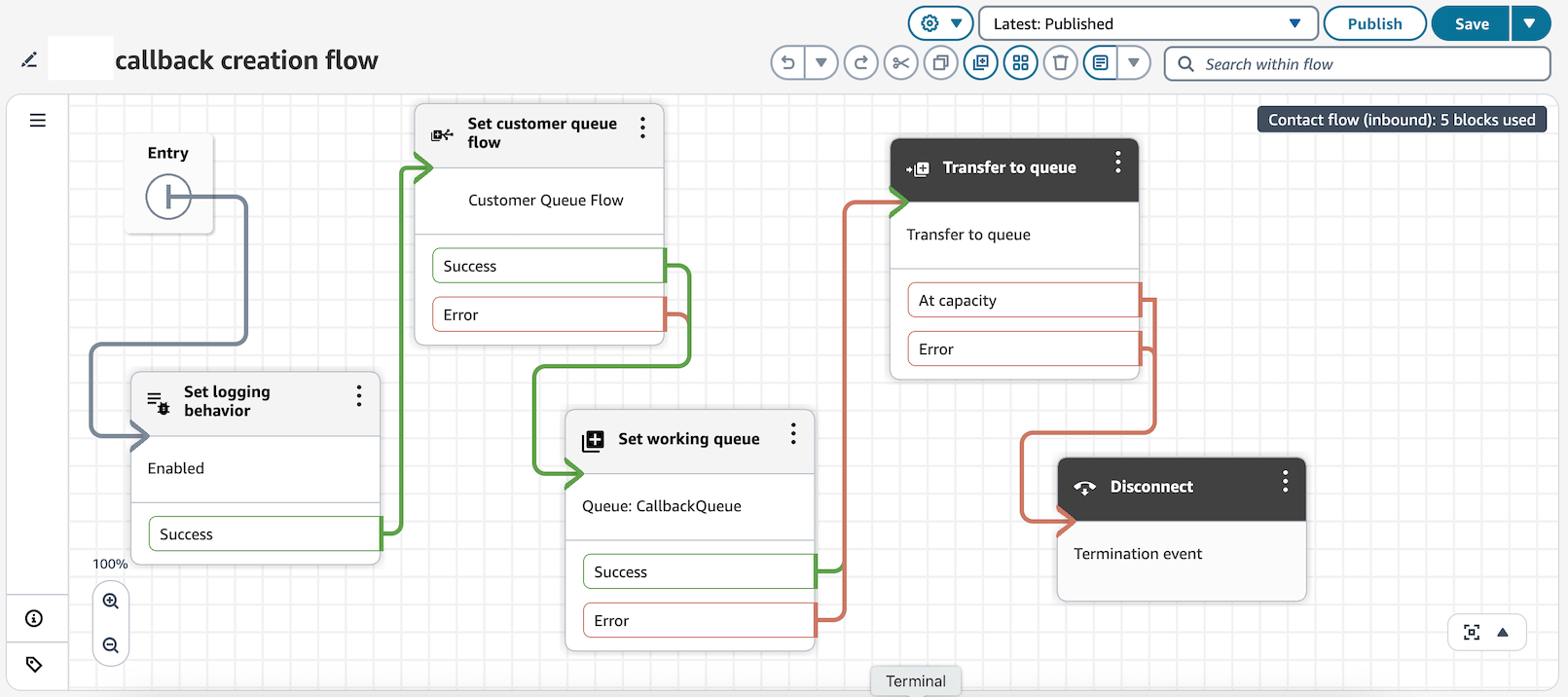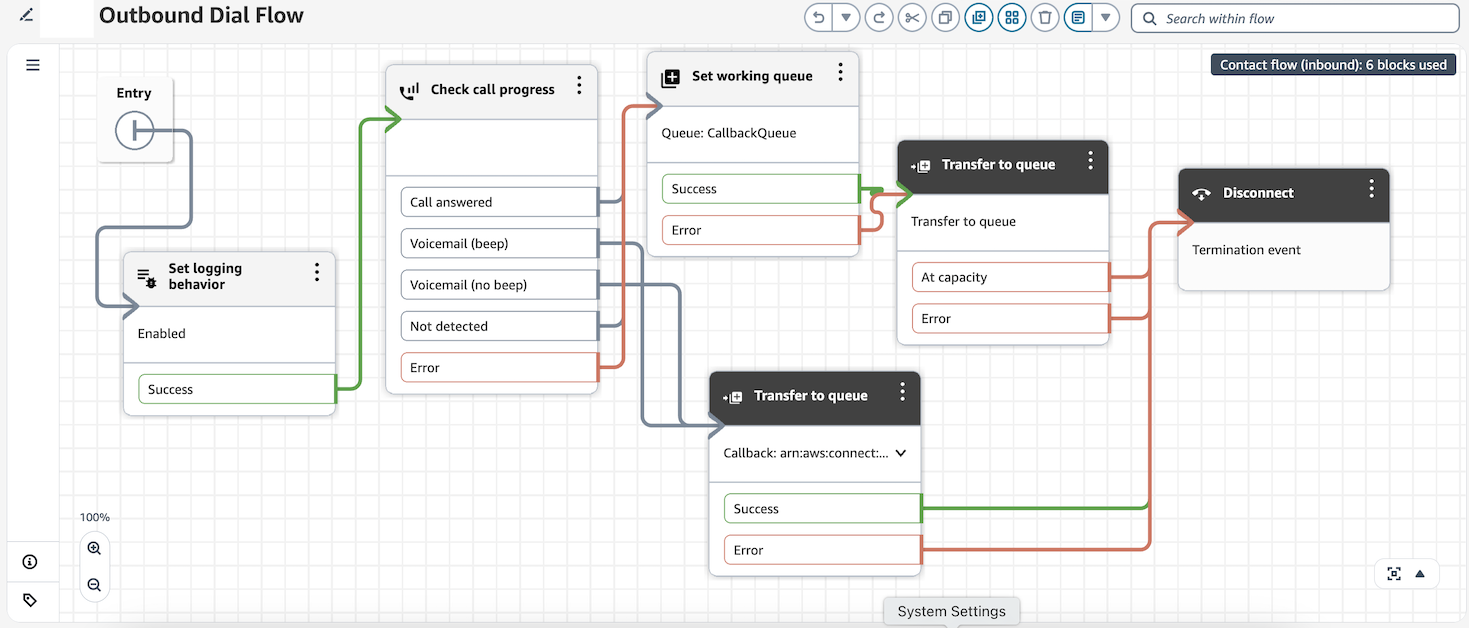Use customer first callback mode in Amazon Connect
When you set up queued callbacks, you have the additional choice of whether to use agent first callback mode or customer first callback mode.
-
Agent first callback mode is the default. The callback is offered to an agent to accept or reject before the call is dialed to a customer.
-
Customer first callback mode is available only when Next Generation Amazon Connect is enabled for your Amazon Connect instance. In this mode, Amazon Connect dials the customer first and only offers the callback to an agent if the customer answers the callback that they've received.
Important
-
Customer first callback mode is not available in the pay-per-feature pricing model.
-
If you disable Next Generation Amazon Connect after you've already activated and started using customer first callback, customer first callback mode is also disabled.
Contents
The lifecycle of a customer first callback
The lifecycle for customer first callbacks is spread across three different contacts, as shown in the following diagram.

Following is a description of each contact.
-
Inbound customer contact (C1) is an inbound voice contact. It looks like every other inbound customer contact.
-
Queued callback contact (C2) is the queued leg of the customer first callback. It has a new initiation method of CALLBACK_CUSTOMER_FIRST_QUEUED.
-
C2 triggers the creation flow, if you selected Set creation flow in the Transfer to queue block. It does this before it is queued in the working queue, and after the Initial delay, if that is specified in the Transfer to queue block.
-
C2 does not support the Maximum number of retries and Minimum time between attempts settings in the Transfer to queue block. That functionality is only available for agent first callbacks.
-
-
Dialed callback contact (C3) is the dialed leg of the customer first callback. It has a new initiation method of CALLBACK_CUSTOMER_FIRST_DIALED.
-
C3 triggers the required outbound callback flow that you specified in the Transfer to queue flow block. You only specify an outbound callback flow for customer first callback mode, not for agent first callback mode.
-
For customer first callbacks, you configure retries and time between attempts in the outbound flow specified for C3, based on the output of the Check call progress flow block. The purpose of this is to determine whether a contact has been answered by a voicemail or human voice.
-
After the customer's presence is confirmed, the flow for C3 should have a Transfer to queue flow block configured to place the contact in its queue to find the next available agent.
-
You can customize the routing priority of this contact within the flow by using the Set routing criteria or Change routing priority / age blocks.
-
Note
-
You must set the final working queue at least once before C2 is created.
-
You can do this in the C1 inbound flow by using the Set working queue. Or, while configuring C2 you can specify the queue in the Transfer to queue block.
-
You can modify the final working queue by using Set creation flow for C2, or by using the outbound flow that you specify for C3.
-
-
When you set the final working queue for the callback at any point in the contact's lifecycle (step C1, C2, or C3), the following stages inherit it.
Metrics for customer first callbacks
You can access the following metrics in either the Queue performance dashboard or by using the GetMetricDataV2 API.
Example contact records for customer first callbacks
Following are example contact records to show what information is stored for the C2 and C3 legs of a customer first callback.
Example C2 queued customer first callback contact record
InitialContactId : C1 (Inbound contact) ContactId : C2 (this contact) PreviousContactId : C1 (Inbound contact) NextContactId : C3 (Dialed customer first callback contact) Channel : VOICE, InitiationMethod : CALLBACK_CUSTOMER_FIRST_QUEUED, ConnectedToSystemTimeStamp : time // Timestamp when callback creation flow got started CustomerEndpoint : customer phone number endpoint DisconnectTimestamp : time // Timestamp indicating contact is disconnected and customer will be dialed DisconnectReason : // Disconnect reason code InitiationTimeStamp : time // Timestamp indicating customer first callback has been created in connect systems QueueInfo : { Arn : arn // Queue arn representing customer first callback queue EnqueueTimeStamp : time // Timestamp indicating customer first callback has been put in queue and waiting out to dial. DequeueTimeStamp : time // Timestamp indicating customer first callback has been taken out from queue to dial out end customer. Duration : time // total time it took connect systems to dial out end customer. }
Example C3 dialed customer first callback contact
InitialContactId : C1 (Inbound contact) ContactId : C3 (this contact) PreviousContactId : C2 (Queued customer first callback contact) Channel : VOICE, InitiationMethod : CALLBACK_CUSTOMER_FIRST_DIALED, ConnectedToSystemTimeStamp : time // Timestamp when the outbound call associated with callback was connected with customer. CustomerEndpoint : customer phone number endpoint SystemEndpoint : Outbound caller id assigned to the outbound queue Agent : { // All agent information associated with the outbound call. // Like Agent Arn, ConnectToAgentTimestamp, ACW duration etc. } AgentConnectionAttempts : number DisconnectTimestamp : time // Timestamp indicating outbound call for the callback is disconnected DisconnectReason : // Disconnect reason code SegmentAttributes : { 'connect:TrafficType' : 'CUSTOMER_FIRST_CALLBACK' }, AnsweringMachineDetectionStatus : HUMAN_ANSWERED|VOICEMAIL_BEEP|VOICEMAIL_NO_BEEP|AMD_UNANSWERED|AMD_UNRESOLVED|AMD_NOT_APPLICABLE|SIT_TONE_BUSY|SIT_TONE_INVALID_NUMBER|SIT_TONE_DETECTED|FAX_MACHINE_DETECTED|AMD_ERROR|AMD_UNRESOLVED_SILENCE(WIP) CustomerVoiceActivity : { GreetingStartTimestamp : timestamp GreetingEndTimestamp : timestamp } InitiationTimeStamp : time // Timestamp indicating start of outbound call to customer QueueInfo : { Arn : arn // Queue arn representing customer first callback queue EnqueueTimeStamp : time // Timestamp indicating customer first callback has been put in queue to join with agent. DequeueTimeStamp : time // Timestamp indicating customer first callback has been taken out from queue to join with agent. Duration : time // total time it took connect systems to join dialed end customer with agent. CallbackTotalQueueDuration : time // total time the customer first callback spent in queue (Includes the total queued time for C2 and C3.) }
Sample flows for customer first callbacks
The following sample flows show how you can configure a flow for customer first callbacks.
Sample Inbound call flow
The following image shows a Transfer to queue block in a flow.

In this flow, the Transfer to queue has Set creation flow configured and an outbound dial flow is specified.

Sample callback creation flow configuration
The following image shows a sample callback creation flow. The Set customer queue flow block is configured so a customer queue flow runs while the callback contact is in queue waiting for agent availability to dial out to customers.

Example outbound dial flow for callbacks
In the outbound dial flow shown in the following image, Amazon Connect evaluates the presence of the customer by using a Check call progress block. If voicemail is detected, a callback contact is recreated. If a customer is detected on other end of the call, the call is transferred to queue for the agent to be joined to the customer.
